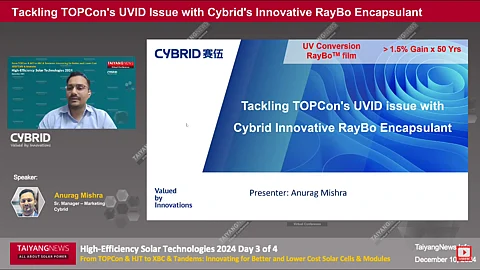

Cybrid's RayBo light conversion film offers enhanced resistance to UVID, humidity, and heat, while also converting UV rays into visible blue light
RayBo film based HJT modules show higher reliability and power gain vs. modules with high-transmittance and UV-cutoff films
The company is extending the benefit of RayBo encapsulant’s ability to absorb UV light, convert it into visible light, and protect the module
The ultraviolet-induced degradation (UVID) mechanism in n-type PV modules, triggered by prolonged exposure to high UV levels from sunlight, poses a potential risk to the long-term reliability of both TOPCon and HJT modules. In HJT cells, extended UV exposure leads to the redistribution of hydrogen near the amorphous silicon (a-Si) passivation and silicon (Si) interface, creating interface defects that act as recombination centers. In contrast, the UV rays in the TOPCon cell structure primarily affect the front passivation layer at the Al₂O₃ and silicon (Si) interface. This degradation results in a significant decay in open-circuit voltage (Voc), leading to a loss in cell efficiency for both TOPCon and HJT modules. To mitigate this major degradation mechanism, the PV industry is innovating at both the cell and module levels. At the module level, several encapsulation film manufacturers are offering specialized films with UV light conversion capabilities for n-type module makers.
At the TaiyangNews High-Efficiency Solar Technologies 2024 Conference, Anurag Mishra, Senior Manager of Marketing at Cybrid Technologies, highlighted the latest RayBo light conversion film and its application in TOPCon and HJT modules (see Cybrid’s presentation here). Cybrid Technologies has a comprehensive presence in PV backsheet, encapsulating film, and tape manufacturing, with an annual capacity of over 50 GW for backsheet and 80 GW for encapsulating films. The company operates 4 manufacturing facilities in China and 1 in Vietnam.
Cybrid’s light conversion film, branded RayBo, was first launched in 2022. This UV light conversion film incorporates a blend of light conversion agents into conventional encapsulation film structures, such as EPE, EVA, and POE. It helps mitigate both the TOPCon and HJT module’s potential UVID-related reliability issues while boosting power gain by converting UV wavelength sunlight into visible wavelength light. The company started to produce IP-protected UV converting agents under license from CHOSHU Industry in 2023. The UV conversion film’s credibility was validated based on the company’s multiple in-house testing results, noted Cybrid. After prolonged UV exposure equivalent to 50 years, only 2% of the light-conversion agent was lost in the UV conversion film, validating RayBo’s high UV resistance. Additionally, no significant decay in transmittance within the UV band was observed after 1,200 kWh of radiation under a 60 W/m² xenon lamp. This demonstrates that the RayBo film, blended with the optimal concentration of UV conversion agents, maintains stable transmittance over time, ensuring consistent energy output. The test specimen was Cybrid’s standard WT22H series 0.5 mm thick EPE film featuring up to 0.067% mass concentration of conversion agent. Furthermore, the extended damp heat (DH) reliability test for up to 2,500 hours reveals less than 10% degradation in its light-conversion ability, proving its resilience in high-humidity environments like coastal areas. However, RayBo has been certified for effective use in the TOPCon module by independent 3rd party laboratories including TÜV NORD and Shanghai Jiao Tong University.
Cybrid’s RayBo film has been adopted by several HJT module manufacturers, including Maxwell and Huasun. A comparative analysis of power output variations between HJT modules using high-transmittance films, UV-cut-off films, and UV-conversion films revealed that while transparent films deliver high output, they tend to be less durable. In contrast, UV-cut-off films are durable but do not provide the same high output. RayBo, however, strikes the perfect balance, offering both reliability and performance, resulting in a 1.5% power gain per module. Additionally, the Huasun HJT module, which incorporates RayBo light conversion film, demonstrated less than 5% power degradation in an extended UV stress test (3 x IEC), further substantiating the film’s long-term reliability. Along with higher UV stress resistance, Cybrid’s comparative analysis of the extended damp heat (DH2000) test between Huasun’s UV-cutoff and Raybo film HJT modules showed that both exhibited the same level of output decay, demonstrating resilience under prolonged damp heat conditions. However, the Raybo film module exhibited higher output power than the UV-cutoff films, likely due to the Raybo film’s superior blue light transmittance property, added Mishra.
Following recent trends of TOPCon modules degrading due to UV rays, Cybrid announces that it is extending the benefits of RayBo encapsulant’s ability such as absorb UV light, convert it into visible light, and protect the module, to TOPCon modules. Cybrid’s internal data shows that while the RayBo film’s UV cut performance is comparable to that of UV cut films, increasing the concentration of UV conversion agents in the RayBo film enhances its UV cut performance. This improvement is attributed to RayBo’s more than 100% blue light transmittance. Additionally, the TOPCon module combined with RayBo UV light conversion film has demonstrated measurable power increases, with up to a 0.53% improvement in energy output compared to the standard high-transmittance film module. It shows that this has a significant impact on the overall ROI of large-scale projects, explains Mishra.
